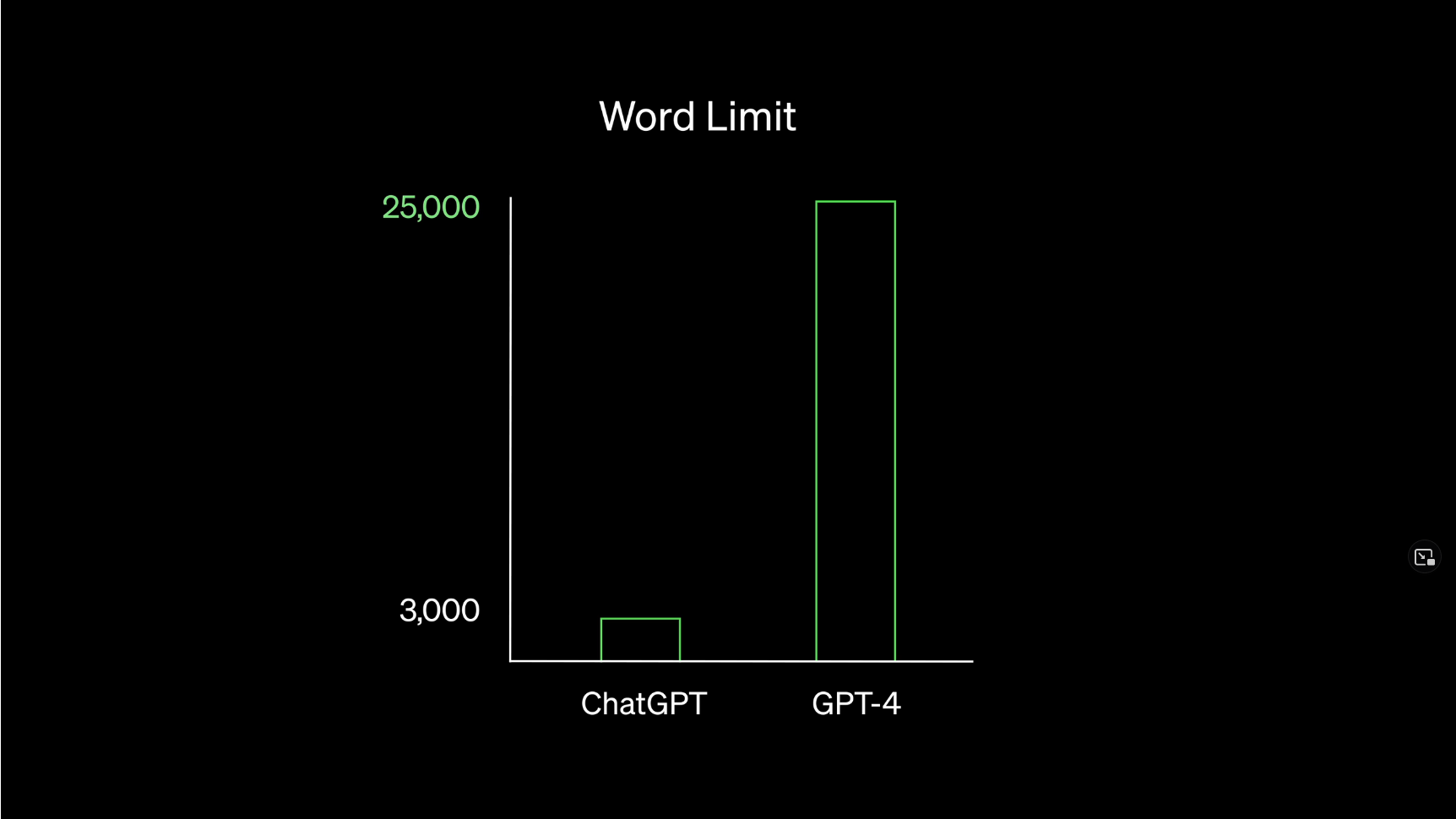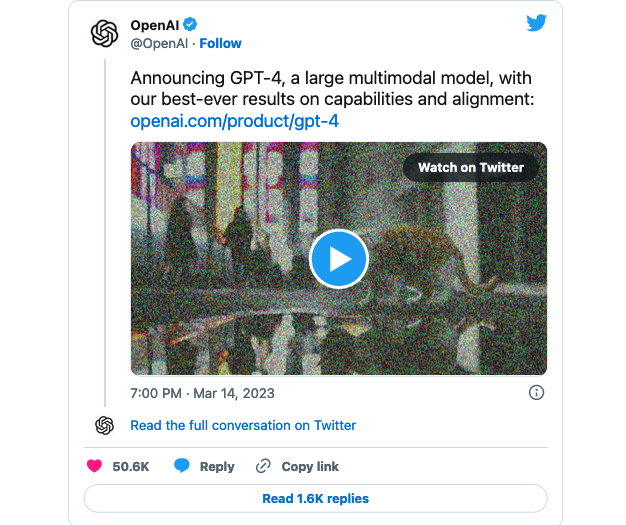As a leading prompt engineering agency, we are excited to introduce the newest product from OpenAI - the GPT-4 model. This revolutionary language model is a significant improvement over its predecessor, ChatGPT, and it is set to change the way we use language in various applications. In this article, we will dive into what GPT-4 is, how it differs from ChatGPT, why it matters, and how to benefit from it in your product or business.
Intro
In the world of artificial intelligence, there are few names that hold as much weight as OpenAI. This research organization has been at the forefront of developing some of the most advanced AI models in the world, and their latest release, the GPT-4 model, has already generated a lot of buzz in the industry.
For those in the field of prompt engineering, GPT-4 is an especially exciting development. This new model promises to be even more powerful and sophisticated than its predecessor, the ChatGPT model. With a greater capacity to understand and generate natural language, GPT-4 has the potential to revolutionize the way we interact with AI and the way we approach natural language processing.
But what exactly is GPT-4, and how is it different from ChatGPT? Why does it matter, and how can you adopt it into your workflow? In this post, we'll dive deep into the world of GPT-4 prompt engineering, exploring its features, capabilities, and potential impact on the field. Whether you're a seasoned AI researcher or just starting out in the world of machine learning, this post will provide valuable insights into one of the most exciting developments in the field of artificial intelligence.
What is GPT-4?
GPT-4 stands for Generative Pre-trained Transformer 4, which is a language model developed by OpenAI. It is the fourth iteration of the GPT series and is considered to be one of the most powerful language models in the world. GPT-4 is built upon the same transformer architecture as its predecessors, but it is much larger and more powerful than any of them.
At its core, GPT-4 is designed to generate human-like text based on a given prompt. It uses machine learning algorithms to analyze and understand the context of a given text prompt and then generates a response that is contextually relevant and coherent. This makes GPT-4 extremely useful for a wide range of applications, including natural language processing, chatbots, and content creation.
GPT-4 is capable of generating up to 25,000 words of text, which is around 8 times more than its predecessor, GPT-3. In addition, GPT-4 is able to understand images and can express logical ideas about them. For example, it can analyze an image and provide insights about what is happening in the picture or generate descriptive captions for it.

Overall, GPT-4 is a highly advanced language model that has the potential to revolutionize the way we interact with machines and communicate with each other. Its sophisticated natural language processing capabilities make it an invaluable tool for businesses, researchers, and developers alike.
OpenAI announced its release on March 14 with this tweet:

GPT-4 is now available to users with the ChatGPT Plus plan.
How is GPT-4 different from ChatGPT?
While ChatGPT was an impressive leap forward in natural language processing, GPT-4 takes things to the next level. Here are some key differences between the two models:
Increased Parameter Count
One of the most obvious differences between ChatGPT and GPT-4 is the size of the models. GPT-4 has a staggering 10 trillion parameters, which is four times the number of parameters in its predecessor, GPT-3. This massive increase in parameters allows GPT-4 to handle more complex tasks and generate longer, more sophisticated text outputs.
Improved Multimodal Capabilities
GPT-4 has been designed to work with more than just text inputs. It also has the ability to understand and work with images, allowing it to generate text that is informed by visual inputs. For example, GPT-4 can analyze an image and generate text that describes the objects in the image, the relationships between those objects, and even the emotions that the image might evoke. For example, GPT-4 can tell us that if the strings in an image of balloons are cut, the balloons will fly away. This kind of logical reasoning about images is a groundbreaking feature in AI technology.

Enhanced Logical Reasoning
Another major improvement in GPT-4 is its ability to perform logical reasoning tasks. The model has been trained to identify and manipulate symbolic representations of logical relationships, which allows it to generate text that reflects complex logical ideas. This means that GPT-4 can help to automate tasks that require complex reasoning and decision-making, such as financial forecasting or risk analysis.
Better Memory and Context Management
GPT-4 has also been designed to better manage memory and context. The model can keep track of a broader range of contextual information, allowing it to generate more coherent and relevant text outputs. This means that GPT-4 can help to automate tasks that require a deeper understanding of context, such as content creation for social media marketing campaigns.
Why does GPT-4 matter?
The release of GPT-4 is a significant milestone in the development of artificial intelligence. This model can generate natural language text that is so fluent and sophisticated that it's sometimes difficult to distinguish it from text written by a human. Its 250 billion parameters make it the largest language model ever created, which means it can process and generate an enormous amount of information with incredible accuracy and speed.
The applications of GPT-4 are almost limitless. It can be used to generate text for a wide variety of purposes, from writing articles and books to composing emails and social media posts. It can also be used to automate customer service interactions, generate chatbot responses, and even write computer code.
But what sets GPT-4 apart from previous language models is its ability to understand and express logical ideas about images. This feature opens up a whole new range of possibilities for using natural language processing in fields such as robotics, computer vision, and autonomous systems.
Another important aspect of GPT-4 is its potential to reduce bias in natural language processing. Previous language models have been criticized for perpetuating harmful stereotypes and reinforcing biases in society. But GPT-4 has been designed to reduce these biases and promote fairness and inclusivity in its output.
GPT-4 also matters because of the impact it will have on the future of work. As more and more tasks are automated, there will be a growing need for individuals with skills in natural language processing and machine learning. GPT-4 is a step forward in the development of AI technologies that can perform complex tasks, which means there will be an increasing demand for professionals who can work with these tools and develop new applications for them.
GPT-4 prompt engineering refers to the use of the OpenAI GPT-4 model in engineering applications that require the generation of human-like natural language responses. The GPT-4 prompt engineering process involves training the GPT-4 model on a specific set of prompts, which are then used to generate text that is relevant to the prompt.
Prompt engineering is a crucial step in using the GPT-4 model for generating text that is accurate and relevant to the task at hand. It involves carefully designing and selecting prompts that will guide the GPT-4 model towards generating text that is specific to the intended application.
Why work with GPT-4 prompt engineers?
While GPT-4 has the potential to transform the way we work with language, it is important to recognize that it is a complex and powerful tool that requires specialized expertise to be used effectively. This is where GPT-4 prompt engineers come in.
GPT-4 prompt engineers are experts in utilizing GPT-4 for various language-related tasks. They have extensive knowledge of the underlying algorithms and can customize the model to suit specific needs. These engineers have experience in creating training data, fine-tuning the model, and integrating it into various workflows.

By working with GPT-4 prompt engineers, businesses can leverage the power of this model without the need for extensive in-house expertise. These engineers can help identify specific use cases for GPT-4 and design solutions that integrate the model into existing workflows.
Additionally, GPT-4 prompt engineers can provide ongoing support and maintenance to ensure that the model is performing optimally. They can monitor the model's performance and fine-tune it as necessary to ensure that it is providing accurate and relevant outputs.
Overall, working with GPT-4 prompt engineers can help businesses unlock the full potential of this powerful language model, saving time and resources while achieving more accurate and sophisticated results.


